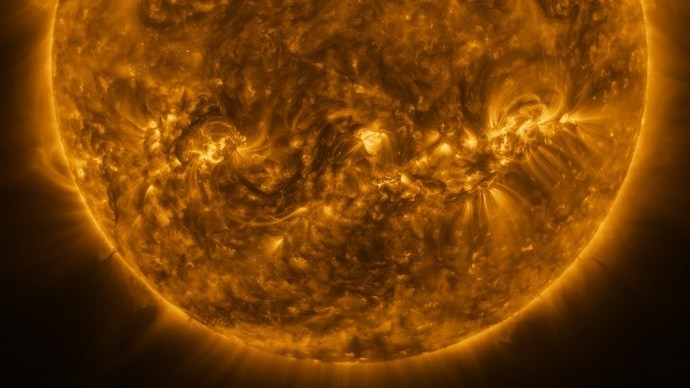SOLAR ORBITER

Disclaimer: Copyright infringement not intended.
Context
- The European Space Agency's Solar Orbiter has captured the most detailed image of the Sun's full disc and outer atmosphere, the corona, to date.
Details
- This remarkable image was taken in extreme ultraviolet light at a wavelength of 17 nanometers, offering unparalleled insight into the intense environment of the Sun's upper atmosphere, which boasts temperatures nearing one million degrees Celsius.
Mission Details
- Solar Orbiter's Mission: This close-up view of the Sun was made possible due to the Solar Orbiter's close approach, orbiting within the range of Mercury. The spacecraft is equipped with a suite of 10 instruments designed to meticulously study the Sun, encompassing its magnetic fields, solar winds, and energetic particles.
- Scientific Implications: The image represents a profound technical achievement and a crucial step forward in comprehending the Sun's impact on the solar system. The data collected from this endeavor will contribute significantly to deciphering the mysteries surrounding the solar wind and the extreme temperatures of the corona, long perplexing astronomers for decades.
About Solar Orbiter
- The Solar Orbiter (SolO) mission, jointly developed by the European Space Agency (ESA) and NASA, aims to study the Sun and its inner heliosphere comprehensively.
Mission Objectives and Significance:
- The primary objective of Solar Orbiter is to gather detailed measurements of the Sun's inner heliosphere, nascent solar wind, and perform close observations of the Sun's polar regions.
- These observations are critical in understanding how the Sun generates and regulates its heliosphere.
Spacecraft Overview:
- The Solar Orbiter spacecraft is three-axis stabilized and features a dedicated heat shield to protect it from extreme solar flux during perihelion.
- Equipped with 21 sensors configured to conduct remote-sensing and in situ experiments.
- Incorporates technology from previous missions, including solar arrays from the BepiColombo Mercury Planetary Orbiter.
Spacecraft Instruments:
Solar Orbiter's payload comprises 10 instruments categorized into heliospheric in-situ instruments and solar remote-sensing instruments. Key instruments include:
- SWA (Solar Wind Plasma Analyser): Measures solar wind ion composition and properties.
- MAG (Magnetometer): Provides precise in situ measurements of the heliospheric magnetic field.
- PHI (Polarimetric and Helioseismic Imager): Offers high-resolution measurements of the photospheric magnetic field and velocity.
- EUI (Extreme Ultraviolet Imager): Images solar atmospheric layers above the photosphere.
- STIX (Spectrometer Telescope for Imaging X-rays): Provides imaging spectroscopy of solar thermal and non-thermal X-ray emission.
Mission Operations and Ground Stations:
- Mission operations involve communication with Earth using ESA's Malargüe ground station in Argentina and backup stations in Australia and Spain.
- During science operations, data is downlinked for eight hours per communication period, with additional passes scheduled if necessary.
Scientific Objectives and Research Goals:
The Solar Orbiter aims to address fundamental questions regarding the Sun's processes:
- Origin and characteristics of solar wind plasma and magnetic fields.
- Solar transients' impact on heliospheric variability.
- Understanding solar eruptions and their production of energetic particle radiation.
- Investigation of the solar dynamo and its influence on the Sun-heliosphere connection.
Mission Progress and Scientific Outputs:
- Launched in February 2020, the spacecraft has completed gravity-assist maneuvers around Venus and Earth, directing it towards the inner Solar System.
- It successfully performed its first close solar pass in March 2022, capturing invaluable data.
Conclusion
The Solar Orbiter mission represents a significant step in studying the Sun's dynamics, offering unprecedented insights into its workings and influence on the heliosphere. Through its advanced instrumentation and international collaboration, it continues to expand our understanding of our closest star.
|
PRACTICE QUESTION Q. Discuss the significance of studying the solar corona and its relevance in understanding space weather phenomena. How does the solar corona impact technological infrastructure on Earth? Explain with examples and mitigation strategies. (250 Words) |





1.png)
